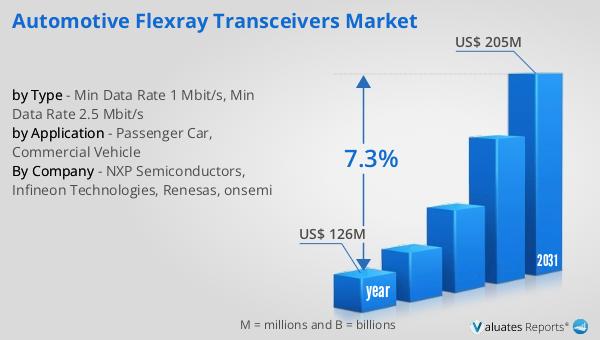List of Tables
Table 1. Global Automotive FlexRay Transceivers Market Value by Type, (US$ Million) & (2024 VS 2031)
Table 2. Global Automotive FlexRay Transceivers Market Value by Application, (US$ Million) & (2024 VS 2031)
Table 3. Global Automotive FlexRay Transceivers Production Capacity (K Units) by Manufacturers in 2024
Table 4. Global Automotive FlexRay Transceivers Production by Manufacturers (2020-2025) & (K Units)
Table 5. Global Automotive FlexRay Transceivers Production Market Share by Manufacturers (2020-2025)
Table 6. Global Automotive FlexRay Transceivers Production Value by Manufacturers (2020-2025) & (US$ Million)
Table 7. Global Automotive FlexRay Transceivers Production Value Share by Manufacturers (2020-2025)
Table 8. Global Key Players of Automotive FlexRay Transceivers, Industry Ranking, 2023 VS 2024
Table 9. Company Type (Tier 1, Tier 2, and Tier 3) & (based on the Production Value in Automotive FlexRay Transceivers as of 2024)
Table 10. Global Market Automotive FlexRay Transceivers Average Price by Manufacturers (US$/Unit) & (2020-2025)
Table 11. Global Key Manufacturers of Automotive FlexRay Transceivers, Manufacturing Base Distribution and Headquarters
Table 12. Global Key Manufacturers of Automotive FlexRay Transceivers, Product Offered and Application
Table 13. Global Key Manufacturers of Automotive FlexRay Transceivers, Date of Enter into This Industry
Table 14. Global Automotive FlexRay Transceivers Manufacturers Market Concentration Ratio (CR5 and HHI)
Table 15. Mergers & Acquisitions, Expansion Plans
Table 16. Global Automotive FlexRay Transceivers Production Value by Region: 2020 VS 2024 VS 2031 (US$ Million)
Table 17. Global Automotive FlexRay Transceivers Production Value (US$ Million) by Region (2020-2025)
Table 18. Global Automotive FlexRay Transceivers Production Value Market Share by Region (2020-2025)
Table 19. Global Automotive FlexRay Transceivers Production Value (US$ Million) Forecast by Region (2026-2031)
Table 20. Global Automotive FlexRay Transceivers Production Value Market Share Forecast by Region (2026-2031)
Table 21. Global Automotive FlexRay Transceivers Production Comparison by Region: 2020 VS 2024 VS 2031 (K Units)
Table 22. Global Automotive FlexRay Transceivers Production (K Units) by Region (2020-2025)
Table 23. Global Automotive FlexRay Transceivers Production Market Share by Region (2020-2025)
Table 24. Global Automotive FlexRay Transceivers Production (K Units) Forecast by Region (2026-2031)
Table 25. Global Automotive FlexRay Transceivers Production Market Share Forecast by Region (2026-2031)
Table 26. Global Automotive FlexRay Transceivers Market Average Price (US$/Unit) by Region (2020-2025)
Table 27. Global Automotive FlexRay Transceivers Market Average Price (US$/Unit) by Region (2026-2031)
Table 28. Global Automotive FlexRay Transceivers Consumption Growth Rate by Region: 2020 VS 2024 VS 2031 (K Units)
Table 29. Global Automotive FlexRay Transceivers Consumption by Region (2020-2025) & (K Units)
Table 30. Global Automotive FlexRay Transceivers Consumption Market Share by Region (2020-2025)
Table 31. Global Automotive FlexRay Transceivers Forecasted Consumption by Region (2026-2031) & (K Units)
Table 32. Global Automotive FlexRay Transceivers Forecasted Consumption Market Share by Region (2026-2031)
Table 33. North America Automotive FlexRay Transceivers Consumption Growth Rate by Country: 2020 VS 2024 VS 2031 (K Units)
Table 34. North America Automotive FlexRay Transceivers Consumption by Country (2020-2025) & (K Units)
Table 35. North America Automotive FlexRay Transceivers Consumption by Country (2026-2031) & (K Units)
Table 36. Europe Automotive FlexRay Transceivers Consumption Growth Rate by Country: 2020 VS 2024 VS 2031 (K Units)
Table 37. Europe Automotive FlexRay Transceivers Consumption by Country (2020-2025) & (K Units)
Table 38. Europe Automotive FlexRay Transceivers Consumption by Country (2026-2031) & (K Units)
Table 39. Asia Pacific Automotive FlexRay Transceivers Consumption Growth Rate by Region: 2020 VS 2024 VS 2031 (K Units)
Table 40. Asia Pacific Automotive FlexRay Transceivers Consumption by Region (2020-2025) & (K Units)
Table 41. Asia Pacific Automotive FlexRay Transceivers Consumption by Region (2026-2031) & (K Units)
Table 42. Latin America, Middle East & Africa Automotive FlexRay Transceivers Consumption Growth Rate by Country: 2020 VS 2024 VS 2031 (K Units)
Table 43. Latin America, Middle East & Africa Automotive FlexRay Transceivers Consumption by Country (2020-2025) & (K Units)
Table 44. Latin America, Middle East & Africa Automotive FlexRay Transceivers Consumption by Country (2026-2031) & (K Units)
Table 45. Global Automotive FlexRay Transceivers Production (K Units) by Type (2020-2025)
Table 46. Global Automotive FlexRay Transceivers Production (K Units) by Type (2026-2031)
Table 47. Global Automotive FlexRay Transceivers Production Market Share by Type (2020-2025)
Table 48. Global Automotive FlexRay Transceivers Production Market Share by Type (2026-2031)
Table 49. Global Automotive FlexRay Transceivers Production Value (US$ Million) by Type (2020-2025)
Table 50. Global Automotive FlexRay Transceivers Production Value (US$ Million) by Type (2026-2031)
Table 51. Global Automotive FlexRay Transceivers Production Value Market Share by Type (2020-2025)
Table 52. Global Automotive FlexRay Transceivers Production Value Market Share by Type (2026-2031)
Table 53. Global Automotive FlexRay Transceivers Price (US$/Unit) by Type (2020-2025)
Table 54. Global Automotive FlexRay Transceivers Price (US$/Unit) by Type (2026-2031)
Table 55. Global Automotive FlexRay Transceivers Production (K Units) by Application (2020-2025)
Table 56. Global Automotive FlexRay Transceivers Production (K Units) by Application (2026-2031)
Table 57. Global Automotive FlexRay Transceivers Production Market Share by Application (2020-2025)
Table 58. Global Automotive FlexRay Transceivers Production Market Share by Application (2026-2031)
Table 59. Global Automotive FlexRay Transceivers Production Value (US$ Million) by Application (2020-2025)
Table 60. Global Automotive FlexRay Transceivers Production Value (US$ Million) by Application (2026-2031)
Table 61. Global Automotive FlexRay Transceivers Production Value Market Share by Application (2020-2025)
Table 62. Global Automotive FlexRay Transceivers Production Value Market Share by Application (2026-2031)
Table 63. Global Automotive FlexRay Transceivers Price (US$/Unit) by Application (2020-2025)
Table 64. Global Automotive FlexRay Transceivers Price (US$/Unit) by Application (2026-2031)
Table 65. NXP Semiconductors Automotive FlexRay Transceivers Company Information
Table 66. NXP Semiconductors Automotive FlexRay Transceivers Specification and Application
Table 67. NXP Semiconductors Automotive FlexRay Transceivers Production (K Units), Value (US$ Million), Price (US$/Unit) and Gross Margin (2020-2025)
Table 68. NXP Semiconductors Main Business and Markets Served
Table 69. NXP Semiconductors Recent Developments/Updates
Table 70. Infineon Technologies Automotive FlexRay Transceivers Company Information
Table 71. Infineon Technologies Automotive FlexRay Transceivers Specification and Application
Table 72. Infineon Technologies Automotive FlexRay Transceivers Production (K Units), Value (US$ Million), Price (US$/Unit) and Gross Margin (2020-2025)
Table 73. Infineon Technologies Main Business and Markets Served
Table 74. Infineon Technologies Recent Developments/Updates
Table 75. Renesas Automotive FlexRay Transceivers Company Information
Table 76. Renesas Automotive FlexRay Transceivers Specification and Application
Table 77. Renesas Automotive FlexRay Transceivers Production (K Units), Value (US$ Million), Price (US$/Unit) and Gross Margin (2020-2025)
Table 78. Renesas Main Business and Markets Served
Table 79. Renesas Recent Developments/Updates
Table 80. onsemi Automotive FlexRay Transceivers Company Information
Table 81. onsemi Automotive FlexRay Transceivers Specification and Application
Table 82. onsemi Automotive FlexRay Transceivers Production (K Units), Value (US$ Million), Price (US$/Unit) and Gross Margin (2020-2025)
Table 83. onsemi Main Business and Markets Served
Table 84. onsemi Recent Developments/Updates
Table 85. Key Raw Materials Lists
Table 86. Raw Materials Key Suppliers Lists
Table 87. Automotive FlexRay Transceivers Distributors List
Table 88. Automotive FlexRay Transceivers Customers List
Table 89. Automotive FlexRay Transceivers Market Trends
Table 90. Automotive FlexRay Transceivers Market Drivers
Table 91. Automotive FlexRay Transceivers Market Challenges
Table 92. Automotive FlexRay Transceivers Market Restraints
Table 93. Research Programs/Design for This Report
Table 94. Key Data Information from Secondary Sources
Table 95. Key Data Information from Primary Sources
Table 96. Authors List of This Report
List of Figures
Figure 1. Product Picture of Automotive FlexRay Transceivers
Figure 2. Global Automotive FlexRay Transceivers Market Value by Type, (US$ Million) & (2020-2031)
Figure 3. Global Automotive FlexRay Transceivers Market Share by Type: 2024 VS 2031
Figure 4. Min Data Rate 1 Mbit/s Product Picture
Figure 5. Min Data Rate 2.5 Mbit/s Product Picture
Figure 6. Global Automotive FlexRay Transceivers Market Value by Application, (US$ Million) & (2020-2031)
Figure 7. Global Automotive FlexRay Transceivers Market Share by Application: 2024 VS 2031
Figure 8. Passenger Car
Figure 9. Commercial Vehicle
Figure 10. Global Automotive FlexRay Transceivers Production Value (US$ Million), 2020 VS 2024 VS 2031
Figure 11. Global Automotive FlexRay Transceivers Production Value (US$ Million) & (2020-2031)
Figure 12. Global Automotive FlexRay Transceivers Production Capacity (K Units) & (2020-2031)
Figure 13. Global Automotive FlexRay Transceivers Production (K Units) & (2020-2031)
Figure 14. Global Automotive FlexRay Transceivers Average Price (US$/Unit) & (2020-2031)
Figure 15. Automotive FlexRay Transceivers Report Years Considered
Figure 16. Automotive FlexRay Transceivers Production Share by Manufacturers in 2024
Figure 17. Global Automotive FlexRay Transceivers Production Value Share by Manufacturers (2024)
Figure 18. Automotive FlexRay Transceivers Market Share by Company Type (Tier 1, Tier 2, and Tier 3): 2020 VS 2024
Figure 19. The Global 5 and 10 Largest Players: Market Share by Automotive FlexRay Transceivers Revenue in 2024
Figure 20. Global Automotive FlexRay Transceivers Production Value by Region: 2020 VS 2024 VS 2031 (US$ Million)
Figure 21. Global Automotive FlexRay Transceivers Production Value Market Share by Region: 2020 VS 2024 VS 2031
Figure 22. Global Automotive FlexRay Transceivers Production Comparison by Region: 2020 VS 2024 VS 2031 (K Units)
Figure 23. Global Automotive FlexRay Transceivers Production Market Share by Region: 2020 VS 2024 VS 2031
Figure 24. North America Automotive FlexRay Transceivers Production Value (US$ Million) Growth Rate (2020-2031)
Figure 25. Europe Automotive FlexRay Transceivers Production Value (US$ Million) Growth Rate (2020-2031)
Figure 26. Japan Automotive FlexRay Transceivers Production Value (US$ Million) Growth Rate (2020-2031)
Figure 27. Global Automotive FlexRay Transceivers Consumption by Region: 2020 VS 2024 VS 2031 (K Units)
Figure 28. Global Automotive FlexRay Transceivers Consumption Market Share by Region: 2020 VS 2024 VS 2031
Figure 29. North America Automotive FlexRay Transceivers Consumption and Growth Rate (2020-2031) & (K Units)
Figure 30. North America Automotive FlexRay Transceivers Consumption Market Share by Country (2020-2031)
Figure 31. U.S. Automotive FlexRay Transceivers Consumption and Growth Rate (2020-2031) & (K Units)
Figure 32. Canada Automotive FlexRay Transceivers Consumption and Growth Rate (2020-2031) & (K Units)
Figure 33. Europe Automotive FlexRay Transceivers Consumption and Growth Rate (2020-2031) & (K Units)
Figure 34. Europe Automotive FlexRay Transceivers Consumption Market Share by Country (2020-2031)
Figure 35. Germany Automotive FlexRay Transceivers Consumption and Growth Rate (2020-2031) & (K Units)
Figure 36. France Automotive FlexRay Transceivers Consumption and Growth Rate (2020-2031) & (K Units)
Figure 37. U.K. Automotive FlexRay Transceivers Consumption and Growth Rate (2020-2031) & (K Units)
Figure 38. Italy Automotive FlexRay Transceivers Consumption and Growth Rate (2020-2031) & (K Units)
Figure 39. Netherlands Automotive FlexRay Transceivers Consumption and Growth Rate (2020-2031) & (K Units)
Figure 40. Asia Pacific Automotive FlexRay Transceivers Consumption and Growth Rate (2020-2031) & (K Units)
Figure 41. Asia Pacific Automotive FlexRay Transceivers Consumption Market Share by Region (2020-2031)
Figure 42. China Automotive FlexRay Transceivers Consumption and Growth Rate (2020-2031) & (K Units)
Figure 43. Japan Automotive FlexRay Transceivers Consumption and Growth Rate (2020-2031) & (K Units)
Figure 44. South Korea Automotive FlexRay Transceivers Consumption and Growth Rate (2020-2031) & (K Units)
Figure 45. China Taiwan Automotive FlexRay Transceivers Consumption and Growth Rate (2020-2031) & (K Units)
Figure 46. Southeast Asia Automotive FlexRay Transceivers Consumption and Growth Rate (2020-2031) & (K Units)
Figure 47. India Automotive FlexRay Transceivers Consumption and Growth Rate (2020-2031) & (K Units)
Figure 48. Latin America, Middle East & Africa Automotive FlexRay Transceivers Consumption and Growth Rate (2020-2031) & (K Units)
Figure 49. Latin America, Middle East & Africa Automotive FlexRay Transceivers Consumption Market Share by Country (2020-2031)
Figure 50. Mexico Automotive FlexRay Transceivers Consumption and Growth Rate (2020-2031) & (K Units)
Figure 51. Brazil Automotive FlexRay Transceivers Consumption and Growth Rate (2020-2031) & (K Units)
Figure 52. Israel Automotive FlexRay Transceivers Consumption and Growth Rate (2020-2031) & (K Units)
Figure 53. Global Production Market Share of Automotive FlexRay Transceivers by Type (2020-2031)
Figure 54. Global Production Value Market Share of Automotive FlexRay Transceivers by Type (2020-2031)
Figure 55. Global Automotive FlexRay Transceivers Price (US$/Unit) by Type (2020-2031)
Figure 56. Global Production Market Share of Automotive FlexRay Transceivers by Application (2020-2031)
Figure 57. Global Production Value Market Share of Automotive FlexRay Transceivers by Application (2020-2031)
Figure 58. Global Automotive FlexRay Transceivers Price (US$/Unit) by Application (2020-2031)
Figure 59. Automotive FlexRay Transceivers Value Chain
Figure 60. Channels of Distribution (Direct Vs Distribution)
Figure 61. Bottom-up and Top-down Approaches for This Report
Figure 62. Data Triangulation


